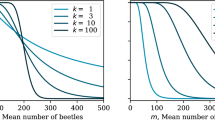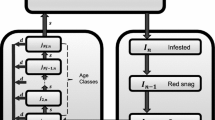Abstract
Mountain pine beetle outbreaks are responsible for widespread tree mortality in pine forests throughout western North America. Intensive outbreaks result in significant economic loss to the timber industry and massive changes to the forest habitat. Because of the time and space scales involved in a beetle outbreak, mathematical models are needed to study the evolution of an outbreak. In this paper we present a partial differential equation model of the flight phase of the mountain pine beetle which includes chemotactic responses and tree defense. We present a numerical method for integrating this model and use this method to investigate the relationship between emergence rate, forest demographic and patterns of beetle attack. In particular we look at how emergence rate affects the beetles' ability to successfully attack strong trees, which may be an indicator of an epidemic outbreak.
Similar content being viewed by others
References
Borden, J. H., L. C. Ryker, L. J. Chong, H. D. Pierce, B. D. Johnston and A. C. Oehlschlager. (1987). Response of the mountain pine beetle,Dendroctonus ponderosae, to five semiochemicals in British Columbia lodgepole pine forests.Can. J. Forest. Res. 17, 118–128.
Burden, R. L. and J. D. Faires. 1985.Numerical Analysis, 3rd ed. Boston: Prindle, Weber and Schmidt.
Conn, J. E., J. D. Borden, B. E. Schott, L. M. Friskie, H. D. Pierce and A. C. Oehlschlager. 1983. Semiochemicals for the mountain pine beetle,Dendroctonus ponderosae, in British Columbia: field trapping studies.Can. J. Forest. Res. 13, 320–324.
Gara, R. I., D. R. Geiszler and W. R. Littke. 1984. Primary attraction of the mountain pine beetle to lodgepole pine in Oregon.Ann. Entomol. Soc. Am. 77, 333–334.
Gear, C. W. 1971.Numerical Initial Value Problems in Ordinary Differential Equations. Englewood Cliffs, NJ: Prentice-Hall.
Geiszler, D. R., V. F. Gallucci and R. I. Gara. 1980. Modeling the dynamics of mountain pine beetle aggregation in a lodgepole pine standOecologia 46 244–253.
Geiszler, D. R. and R. I. Gara. 1978. Mountain pine beetle attack dynamics in lodgepole pine. InTheory and Practice of Mountain Pine, Beetle Management in Lodgepole Pine Forests: Symp. Proc. A. A. Berryman, G. D. Amman and R. W. Stark (Eds). Pullman, WA: Washington State Univ.
Hughes, P. R. 1973.Dendroctonus: production of pheromones and related compounds in response to host monoterpenes.Zeit. Angew. Ent. 73, 294–312.
Hunt, D. W. A., J. H. Borden, B. S. Lindgren and G. Gries. 1989. The role of autoxidation of alpha pinene in the production of pheromones ofDendroctonus ponderosae.Can. J. Forest. Res. 19, 1275–1282.
Hynum, B. G. and A. A. Berryman. 1980.Dendroctonus ponderosae (Coleoptera: Scolytidae): preaggregation landing and gallery initiation on lodgepole pine.Can. Entomol. 112, 185–191.
McCambridge, W. F. 1967. Nature of induced attacks by the black hills beetle,Dendroctonus ponderosae (Coleoptera: Scolytidae).Ann. Entomol. Soc. Am 60, 920–928.
Moeck, H. A. and C. S. Simmons. 1991. Primary attraction of mountain pine beetle to bolts of lodgepole pine.Can. Entomol. 123, 299–304.
Nebeker, T. E., J. D. Hodges and C. A. Blanche. 1993. Host responses to bark beetle pathogen colonization. InBeetle-Pathogen Interactions in Conifer Forests, T. D. Schowalter and G. M. Filip (Eds). New York: Academic Press.
Norris, D. M. and J. E. Baker. 1967. Feeding response of Scolytus to chemical stimuli in the bark of Ulmus.J. Insect Phys. 13, 955–962.
Pitman, G. B. 1971. Trans-verbenol and alpha-pinene: their utility in manipulation of the mountain pine beetle.J. Econ. Entomol. 64, 426–430.
Pitman, G. B., J. P. Vite, G. W. Kinzer and A. F. Fentiman. 1968. Bark beetle attractants: trans-verbenol isolated fromDendroctonus.Nature 218, 168–169.
Powell, J. A. and J. D. Rose, 1996. Local consequences of a global model for mountain pine beetle mass attack.Dynamics Stability Syst.12.
Powell, J., J. A. Logan and B. J. Bentz. 1995. Local projection of a global model of mountain pine beetle attacks.J. Theort Biol. 179, 243–260.
Press, W. H., W. T. Vetterling, S. A. Teukolsky and B. P. Flannery. 1992.Numerical Recipes in C, 2nd ed. London: Cambridge Univ. Press.
Prokopy, R. J. 1980. Epideictic pheromones influencing spacing patterns of phytophagous insects. InSemiochemicals: Their Role in Pest Control, D. A. Norlund, R. L. Jones and W. J. Lewis (Eds), New York: Wiley.
Raffa K. F. 1988. Host orientation behavior ofDendroctonus ponderosae: integration of token stimuli and host defenses. InMechanism of Woody Plant Resistance to Insects and Pathogens, W. J. Mattson, J. Levieux and C. Bernard-Dagen (Eds), pp. 369–390. New York: Springer-Verlag.
Raffa, K. F. and A. A. Berryman. 1979. Flight responses and host selection by bark beetles. InDispersal of Forest Insects: Evaluation, Theory and Management Implications, A. A. Berryman and L. Safranyik (Eds), pp. 213–233, Pullman, WA: Washington State University.
Raffa, K. F., T. W. Phillips and S. M. Salom. 1993. Strategies and mechanisms of host colonization by bark beetles. InBeetle-Pathogen Interactions in Conifer Forests, T. D. Schowalter and G. M. Filip (Eds), pp. 103–120. New York: Academic Press.
Raffa, K. F. and A. A. Berryman. 1982. Gustatory cues in the orientation ofDendroctonus ponderosae (Coleoptera: Scolytidae) to host trees.Can. Entomol. 114, 97–104.
Raffa, K. F., T. W. Philips and S. M. Salom. 1993. Strategies and mechanisms of host colonization by bark beetles. InBeetle-Pathogen Interactions in Conifer Forests, T. D. Schowalter and G. M. Filip (Eds), pp. 103–120. New York: Academic Press.
Rasmussen, L. A. 1974. Flight and attack behavior of mountain pine beetle in lodgepole pine of northern Utah and southern Idaho. Research Note INT-18, USDA Forest Service.
Reid, R. W., H. S. Whitney and J. A. Watson. 1967. Reactions of lodgepole pine to attack byDendroctonus ponderosae hopkins and the blue stain fungi.Can. J. Botany 45, 1115–1116.
Renwick, J. A. A. and J. P. Vite. 1970. Systems of chemical communication inDendroctonus.Contrib. Boyce Thompson Inst. 23, 355–360.
Roe, A. L and G. D. Amman. 1970. The mountain pine beetle in lodgepole pine forests. Research Paper INT-71, USDA Forest Service.
Safranyik, L., R. Silversides, L. H. McMullen and D. A. Linton. 1989. An empirical approach to modeling the local dispersal of the mountain pine beetle (Dendroctonus ponderosae hopk.) in relation to sources of attraction, wind direction and speed.J. Appl. Entomol. 108, 498–511.
Schmitz, R. F. 1988. Understanding Scolytid problems in lodgepole pine forests: the need for an integrated approach. InIntegrated Control of Scolytid Bark Beetles. T. L. Payne and H. Saarenmaa (Eds). Blacksburg, VA: Virginia Polytechnic Institute and State University.
Schonherr, J. 1976. Mountain pine beetle: visual behavior related to integrated control. InProceedings, XVI IUFRO World Congress, Oslo, Norway, pp. 449–452.
Schowalter T. D. and G. M. Filip (Eds). 1993.Beetle-Pathogen Interactions in Conifer Forests. New York: Academic Press.
Sheppard, R. F. 1966. Factors influencing the orientation and rates of activity ofDendroctonus ponderosae (Coleoptera: Scolytidae).Can. Entomol. 98, 507–518.
Smith, R. H. 1963. Toxicity of pine resin vapors to three species ofDendroctonus bark beetles.J. Econ. Entomol. 56, 827–831.
Smith, R. H. 1966. Resin quality as a factor in the resistance of pines to bark beetles. InProceedings of the NATO and National Science Foundation, H. D. England, R. E. Gerhold, R. E. McDermot, E. J. Schreiner and J. A. Winieski (Eds), pp. 189–196. Oxford, England: Pergamon.
Tkacz, B. M. and R. F. Schmitz. 1986. Association of an endemic mountain pine beetle population with lodgepole pine infected byArmillaria root disease in Utah. Research Note INT-353, USDA Forest Service.
White, P. and J. Powell. 1996. Spatial invasion of pine beetles into lodgepole forests: a numerical approach. Unpublished manuscript.
Wood, D. L. 1972. Selection and colonization of ponderosa pine by bark beetles.Symp. Roy. Entomol. Soc. London 6, 110–117.
Author information
Authors and Affiliations
Rights and permissions
About this article
Cite this article
White, P., Powell, J. Phase transition from environmental to dynamic determinism in mountain pine beetle attack. Bltn Mathcal Biology 59, 609–643 (1997). https://doi.org/10.1007/BF02458422
Received:
Revised:
Issue Date:
DOI: https://doi.org/10.1007/BF02458422




